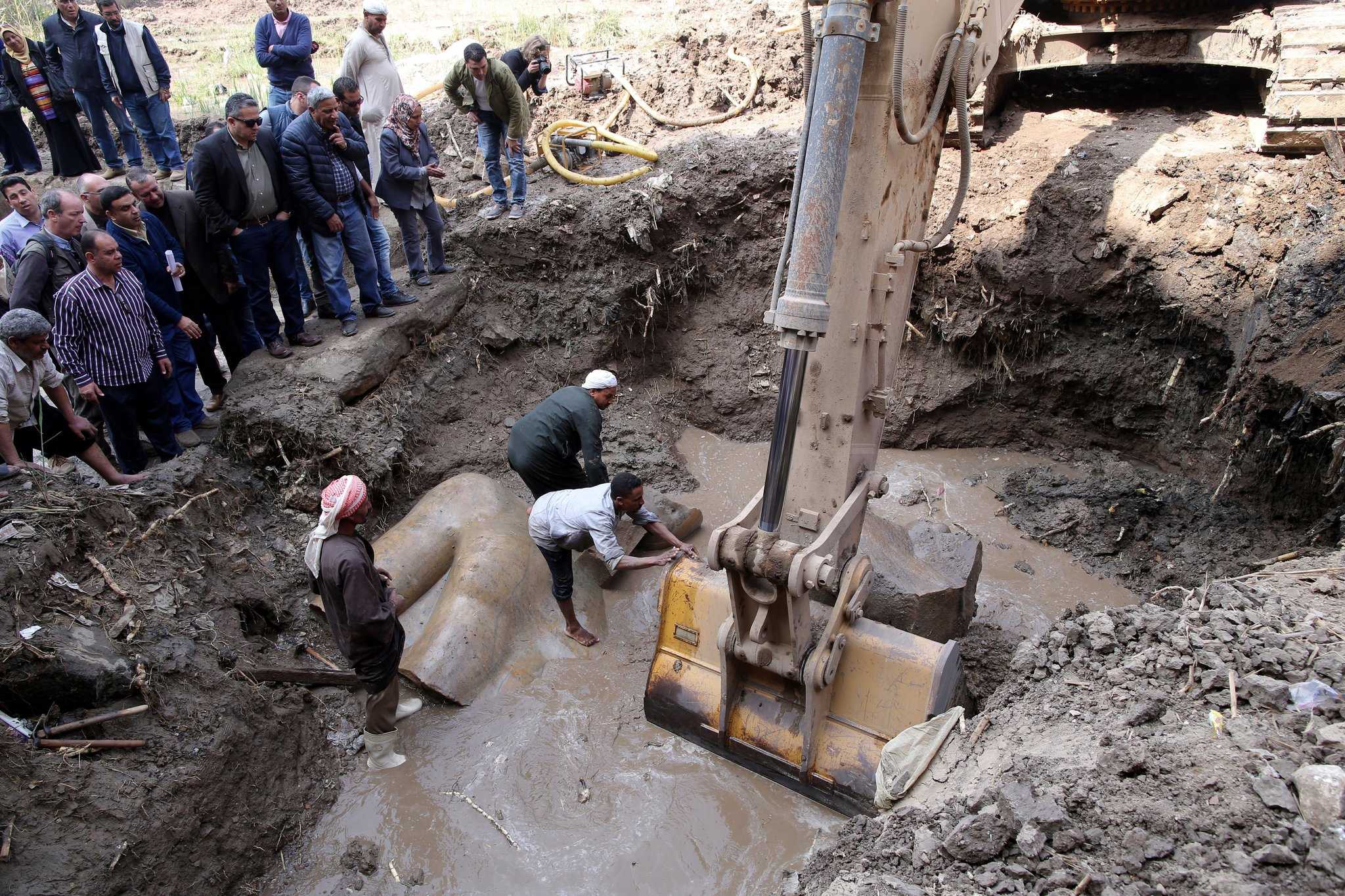
CAIRO — The gritty, working-class neighborhood of Matariya in northeast Cairo brims with noise and poverty, a place where motorized rickshaws vie with donkey carts on narrow, trash-strewn streets. But this week, archaeologists began pulling from a patch of barren ground a glistening 26-foot statue they say might be a world-class find.
If they are especially lucky, the colossus will be determined to be a likeness of Pharaoh Ramses II, one of the most famous rulers of ancient Egypt. That mystery will not be solved until next week, when they hope to finish the excavation and can look for any inscriptions on the quartzite statue.
Yet, for now, they are excited by the discovery itself, saying the statue is at least 3,000 years old, just the type of artifact they hoped to recover before further building in the teeming neighborhood makes such treasures impossible to find.
CAIRO — The gritty, working-class neighborhood of Matariya in northeast Cairo brims with noise and poverty, a place where motorized rickshaws vie with donkey carts on narrow, trash-strewn streets. But this week, archaeologists began pulling from a patch of barren ground a glistening 26-foot statue they say might be a world-class find.
If they are especially lucky, the colossus will be determined to be a likeness of Pharaoh Ramses II, one of the most famous rulers of ancient Egypt. That mystery will not be solved until next week, when they hope to finish the excavation and can look for any inscriptions on the quartzite statue.
Yet, for now, they are excited by the discovery itself, saying the statue is at least 3,000 years old, just the type of artifact they hoped to recover before further building in the teeming neighborhood makes such treasures impossible to find.

“This was a great surprise,” said Dietrich Raue, a director of a team of German and Egyptian archaeologists who have been excavating a vast temple complex at the site since 2012. “We had to clear the area before any future construction work and because the monuments are below the level of the groundwater. The quality of the stone is fantastic, and it has an amazing art historical value.”
The first sign of the colossus came on Tuesday when excavation workers uncovered the lower part of the statue’s chin. On Thursday, archaeologists and residents watched as a hydraulic excavator lifted the statue’s broken crown, glistening with water and mud, from the ground.
Later, smiling children posed for photographs as they leaned against the fragment.
The team also found part of a life-size limestone statue of Seti II, another pharaoh and a grandson of Ramses II. Egypt’s Antiquities Ministry hailed that as an important find as well, although it was not the first in Matariya, which was built on land that was once Heliopolis, an ancient city near the Nile.
More than 150 people are working on the current dig — most of them Egyptian archaeologists and workers, along with a small number of German academics and European specialists. The archaeologists are rushing to uncover as much as they can of the temple complex before local construction projects, some illegal, cover the land.

Houses and building sites border the excavation zone, and sometimes during the dig, workers have had to clear trash and animal carcasses, according to Salima Ikram, an Egyptian member of the team. Once new buildings go up, further excavation will become impossible. “It’s a race against time,” she said.
Establishing the identity of the colossus is complicated because it has been broken into pieces and only fragments of the face have been found. Dr. Raue said it might have been destroyed by early Christians, or by the Muslim rulers of Cairo in the 11th century as they used limestone stonework from ancient temples to build the city’s fortifications.
But statues like the colossus were cast aside because they were made from quartzite.
Ramses II was a formidable figure, not only in Egypt but across much of the ancient world. During his reign, from 1279 to 1213 B.C., he expanded his empire east to present-day Syria and south into Sudan. He was also known for monumental building projects, including sprawling sun temples filled with statues of himself, one of which was discovered under a Cairo marketplace in 2006.
The discovery of the buried colossus may also have strong literary echoes. A shattered statue of Ramses II was the subject of Ozymandias, a celebrated poem by the 19th-century English romantic poet Percy Bysshe Shelley. (Ozymandias was the name of Ramses II in ancient Greek.)

The poem speaks of the discovery of a broken statue in the desert bearing the inscription, “My name is Ozymandias, king of kings: Look on my works, ye Mighty, and despair!” — an image sometimes used to symbolize human mortality and the impermanence of empire.
Shelley began writing the poem in 1817, soon after the British Museum announced that it had acquired a fragment of another statue of Ramses II that had been taken from an ancient temple at Thebes, in modern-day Luxor, by an Italian adventurer. On Monday, archaeologists will look for an inscription on the back pillar of the latest find, to see if it is indeed Ramses II.
It could provide some badly needed good news for Egypt’s embattled tourism industry, which has been in a crippling decline since the 2011 uprising that toppled President Hosni Mubarak. Visitors to Egypt dropped to 5.4 million in 2016 from 14.7 million in 2010, although there has been a small upswing in recent months.
If the colossus is confirmed to be Ramses II, experts say they will piece it together and move it to the entrance of the Grand Egyptian Museum, the world’s largest archaeological museum currently under construction near the pyramids of Giza and set to open next year.
We’re interested in your feedback on this page. Tell us what you think.




























